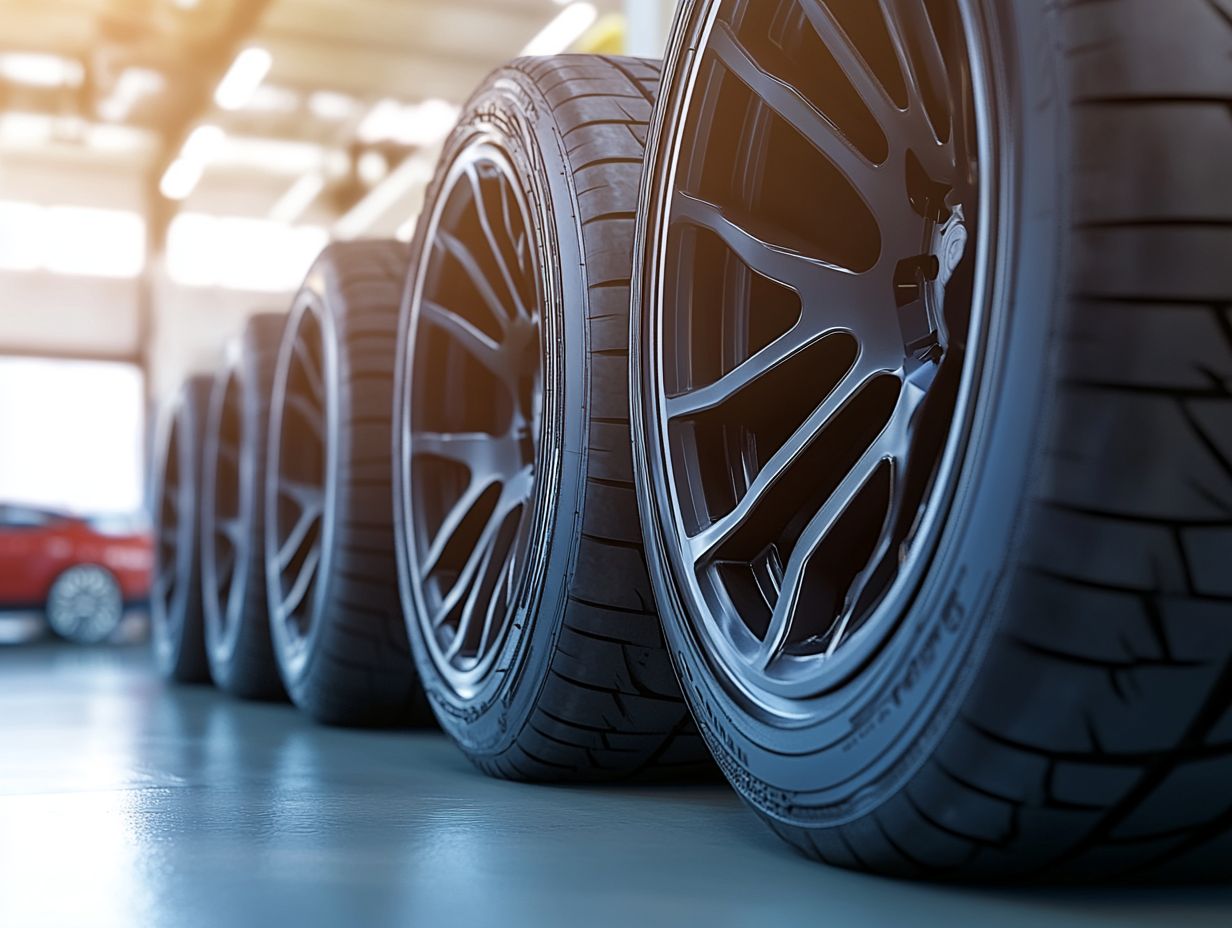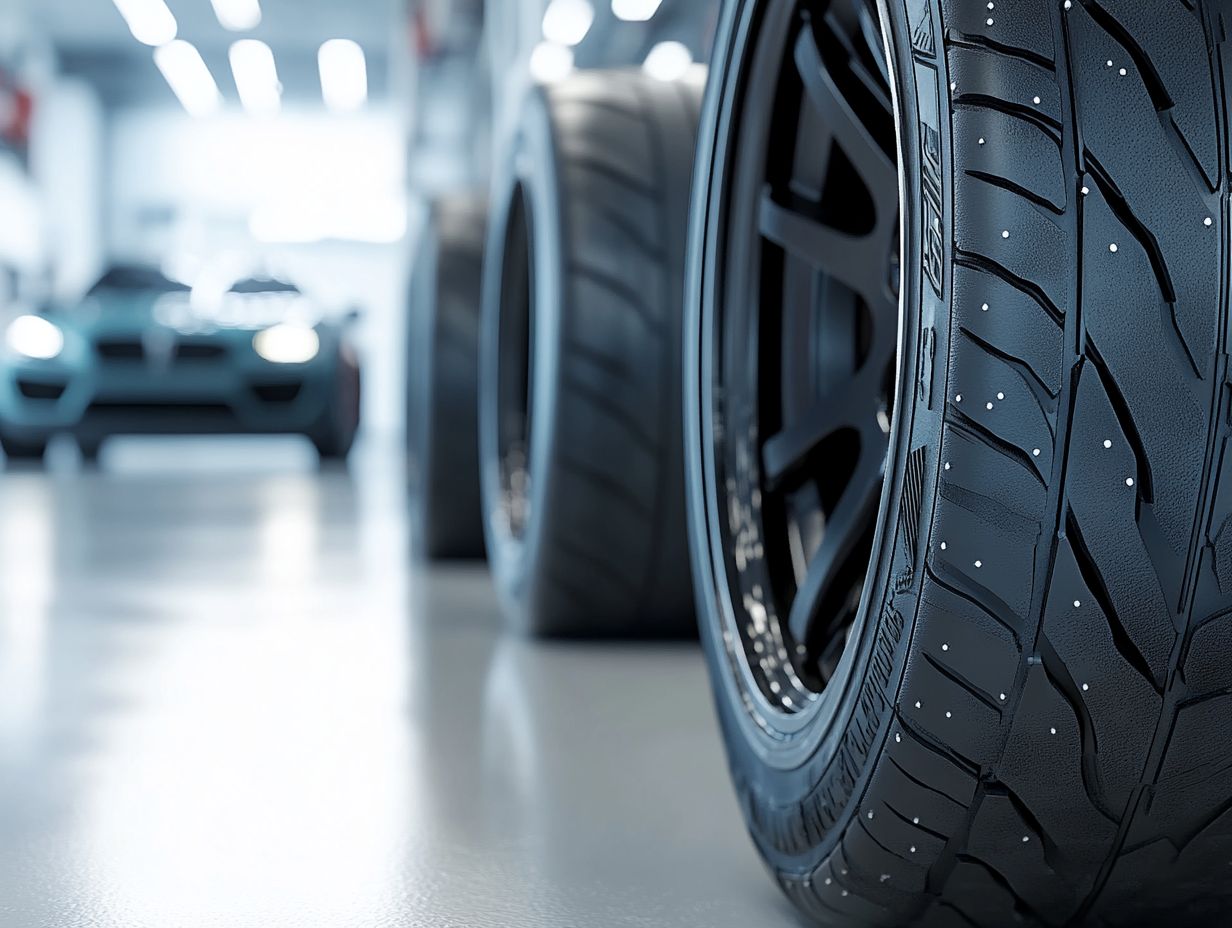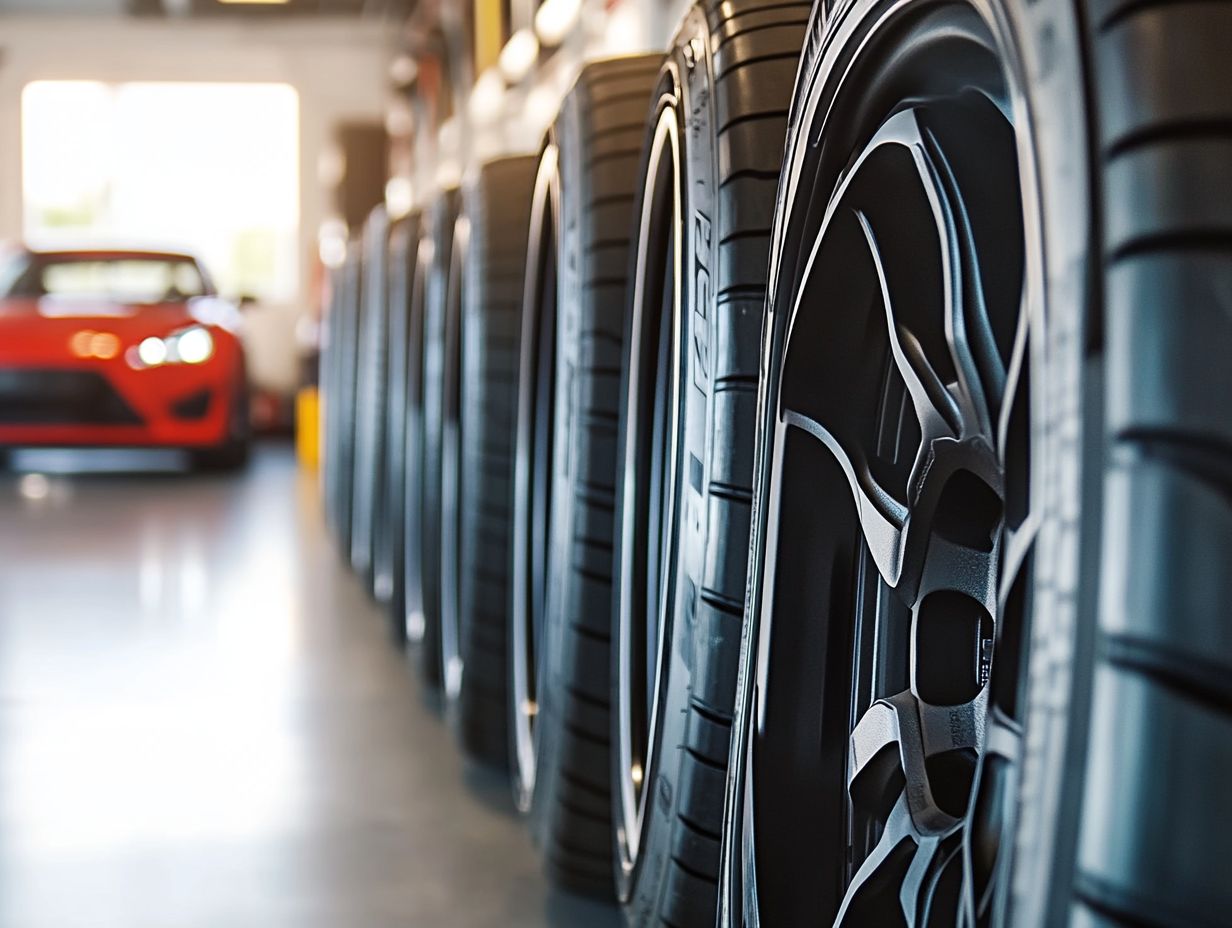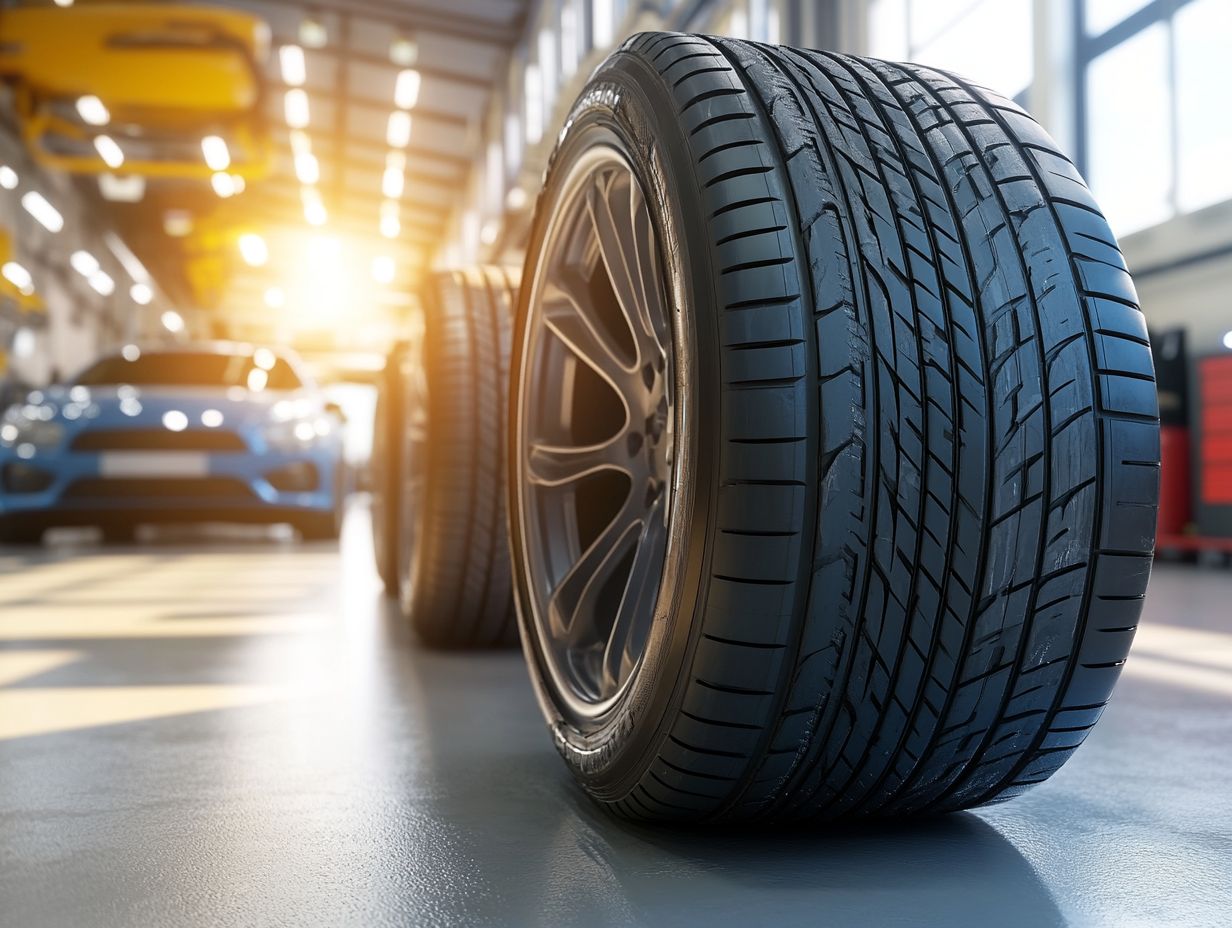How to Choose Performance Tires for Your Car
Choosing the right performance tires for your car is essential for ensuring both safety and driving pleasure. These specialized tires are made to improve handling, grip, and overall performance. It’s important to remember that not all performance tires are created equal.
This article delves into what truly defines a performance tire. We will highlight the key factors you should consider when making your selection, along with the various types available for different driving conditions.
Whether you re a weekend racer or an everyday commuter, understanding these factors will empower you to make a choice that perfectly aligns with your needs. Get ready to enjoy every drive with confidence and style!
Contents
- Key Takeaways:
- Understanding Performance Tires
- Factors to Consider When Choosing Performance Tires
- Types of Performance Tires
- How to Choose the Right Performance Tires for Your Car
- Frequently Asked Questions
- What are performance tires and why should I choose them for my car?
- How do I know if performance tires are the right choice for my car?
- What are the different types of performance tires available in the market?
- How do I choose the right size of performance tires for my car?
- What other factors should I consider when choosing performance tires for my car?
- How do I maintain and care for my performance tires?
Key Takeaways:

- Performance tires are designed for better traction and handling, making them ideal for drivers seeking improved road performance.
- Consider tire size and tread pattern to ensure the best fit for your driving needs.
- There are different types of performance tires, including summer, all-season, and winter, each suited to specific weather conditions.
Understanding Performance Tires
Performance tires are made to elevate your driving experience under various conditions, emphasizing key attributes like traction, handling, grip, and comfort. These tires are engineered to provide exceptional performance, enhancing both safety and fuel efficiency, which makes them essential for both enthusiasts and everyday drivers.
Knowing the differences among the various types of performance tires whether summer, winter, or all-season is vital for selecting the right option tailored to your specific driving conditions and preferences. This insight can greatly improve your car’s performance and your driving enjoyment.
What Makes a Tire ‘Performance’?
A performance tire stands out due to its specialized tread design and unique rubber compound, working in harmony to enhance grip and handling across various driving conditions.
These features ensure that the tire delivers optimal performance, especially during high-speed maneuvers and on winding roads. You’ll notice that the tread pattern often incorporates wider grooves and sipes, which not only enhance water evacuation but also increase surface contact, providing you with better traction when cornering or accelerating.
The advanced rubber compounds are engineered to remain flexible even in fluctuating temperatures, promoting tire longevity while ensuring a strong grip. As a result, when you invest in performance tires, you can look forward to an exhilarating driving experience, paired with improved safety and comfort on both dry and wet surfaces.
Factors to Consider When Choosing Performance Tires
Selecting the ideal performance tires requires careful consideration of several key factors. You’ll need to assess tire size, fit, tread pattern, and design, all of which play a significant role in enhancing your vehicle’s performance and ensuring safety on the road. For more information on how to choose the right tires for your vehicle, consider these essential aspects.
Tire Size and Fit
Tire size and fit are crucial elements to consider when selecting performance tires, as they need to align perfectly with your vehicle’s specifications for optimal performance and safety.
When you choose the right tire dimensions considering width, aspect ratio, and diameter you’re not just influencing acceleration efficiency; you’re also enhancing the overall comfort of your rides. An improperly fitted or mismatched tire can compromise your grip on the road, negatively impacting cornering stability and increasing braking distances.
By adhering to the manufacturer s guidelines regarding load ratings and speed ratings, you ensure that your tires can meet the demands of your specific vehicle. This is vital for maximizing your overall driving experience. The correct tire fit can significantly elevate your cornering precision, making every turn and maneuver feel more fluid and enjoyable.
Make sure to check your vehicle’s specifications for the perfect fit before you buy!
Tread Pattern and Design

The tread pattern and design of performance tires are essential elements that directly influence your vehicle’s traction and handling, particularly in varying driving conditions.
Different tread designs be it directional, symmetrical, or asymmetrical play a significant role in how your tires engage with the road surface. For example, a directional tread is specifically engineered for wet conditions, effectively channeling water away to enhance grip and minimize the risk of hydroplaning, which is when your tires lose grip on wet roads.
On the other hand, symmetrical patterns tend to provide a quieter ride, making them ideal for everyday driving. Meanwhile, asymmetrical designs excel on dry surfaces, striking a balance between noise levels and grip.
Choosing the right tread pattern will ensure you enjoy an optimal driving experience across a variety of terrains, from smooth highways to rugged backroads, all while enhancing your vehicle’s stability and responsiveness.
Speed and Load Ratings
Speed and load ratings are essential specifications for performance tires, determining the maximum speed and weight each tire can handle during operation.
Understanding these ratings is crucial for any driver who aims to maintain safety and optimal performance on the road. The speed rating reveals the maximum speed capability under specific conditions, while the load rating indicates the tire’s capacity to support weight.
By selecting tires that align with your driving habits whether you’re conquering winding mountain roads, cruising on the highway, or maneuvering through city streets you can significantly enhance handling, stability, and response.
Don t forget to think about factors such as weather conditions and vehicle type, as these elements play a critical role in tire selection and your overall driving experience.
Types of Performance Tires
Performance tires come in several distinct categories summer tires, all-season tires, and winter tires each carefully designed to excel under certain weather situations. Knowing which type suits your needs can elevate your driving experience to new heights.
Summer Tires
Summer tires are carefully designed to elevate your driving experience in warm weather, providing exceptional traction and handling on both dry and wet roads.
These specialized tires are crafted with a unique rubber compound that maintains flexibility in higher temperatures, ensuring optimal grip. Their tread patterns are designed to maximize road contact, allowing you to navigate turns and sudden stops with confidence.
Unlike all-season or winter tires, summer options forego the deeper grooves that could compromise stability in warmer conditions. This design boosts traction and helps with fuel efficiency, making them a superb choice for those who prioritize performance during summer driving adventures.
All-Season Tires
All-season tires offer a versatile solution for drivers who seek performance across a spectrum of weather conditions without the hassle of seasonal tire changes.
Their unique design strikingly balances the demands of summer and winter driving, making them the perfect choice for those who desire comfort and reliability throughout the year.
The tread patterns on all-season tires enhance traction on both wet and dry surfaces, ensuring a smoother ride no matter the season. These tires are crafted with compounds that remain flexible in lower temperatures while delivering the necessary grip during warmer months.
As a result, you’ll have peace of mind knowing your tires have got you covered with consistent performance, effectively reducing the hassle and expense associated with frequently changing tires.
Winter Tires

Winter tires are crafted to provide exceptional traction and performance in cold weather, snow, and icy conditions. They are essential for your winter driving safety.
These specialized tires boast unique tread patterns with deeper grooves and sipes, enhancing grip on slippery surfaces. Unlike standard tires that may lose flexibility in low temperatures, winter tires utilize special rubber materials that stay pliable even when temperatures drop. This ensures optimal contact with the road.
This combination of innovative tread design and appropriate materials supercharges your handling, reduces braking distances, and grants you peace of mind during the most challenging winter months.
When navigating snowy landscapes, you ll find greater confidence and control. Thus, winter tires are a must-have for anyone facing the challenges of cold weather driving.
How to Choose the Right Performance Tires for Your Car
Choosing the right performance tires for your car requires a deep understanding of your unique driving style and needs. It’s essential to engage with professionals who can provide expert recommendations tailored to your specific requirements, including insights on how to choose the right tires for performance.
Matching Tires to Your Driving Style and Needs
Matching performance tires to your unique driving style is crucial for ensuring maximum safety and comfort on the road.
Every driver approaches the highway with their own flair. Some prioritize speed and agility, while others seek smoothness and stability. By understanding your habits like whether you often take tight corners or frequently drive in varied weather conditions you can more accurately assess your tire requirements.
For example, performance tires crafted for high grip may be perfect if you relish spirited driving, providing the traction and responsiveness you crave. On the other hand, if safety in wet conditions is your top priority, all-season tires could be the better choice.
Evaluating your personal driving patterns not only guides your tire selections but also elevates your vehicle’s overall performance. This culminates in a safer and more enjoyable driving experience.
Consulting with a Professional
Consulting with a professional can offer you invaluable insights when selecting the perfect performance tires. Their expertise helps you navigate the myriad of options available.
They provide personalized recommendations tailored to your unique driving style, vehicle type, and specific road conditions. During a consultation, you ll gain a deeper understanding of essential tire features, such as tread patterns, compound materials, and performance ratings.
This customized approach ensures that the tires you select not only meet safety standards but also enhance handling and stability. This results in a smoother driving experience. By tapping into their knowledge, you can maximize performance capabilities while minimizing potential risks.
Frequently Asked Questions
What are performance tires and why should I choose them for my car?

Performance tires are specially designed tires that offer superior grip, handling, and responsiveness. They are ideal for those seeking better performance and safety on the road.
How do I know if performance tires are the right choice for my car?
If you enjoy driving and want to improve your car’s handling and performance, then performance tires are the right choice for you. They are also a great option for those living in areas with harsh weather conditions.
What are the different types of performance tires available in the market?
There are three main types of performance tires: summer, all-season, and winter. Summer tires offer the best performance in dry and wet conditions, while all-season tires are a good all-around choice. Winter tires are designed for extreme weather and provide better traction on snow and ice.
Visit your local tire shop today to find the perfect winter tires for your vehicle!
How do I choose the right size of performance tires for my car?
Your performance tires must match your car’s wheel size. Check your vehicle’s manual or the sidewall of your current tires for this information.
Choosing the correct size ensures a proper fit and optimal performance.
What other factors should I consider when choosing performance tires for my car?
Also, consider the speed and weight limits of the tires. These ratings show how fast and how much weight your tires can safely handle.
Selecting tires with the right ratings is key for both safety and performance.
How do I maintain and care for my performance tires?
To keep your tires lasting longer, regularly check their air pressure. Rotate them every 5,000-7,000 miles and replace them when they wear down.
Drive carefully to preserve your tires, and clean them often to remove debris.
